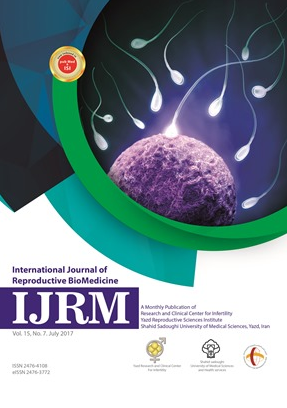
International Journal of Reproductive BioMedicine
ISSN: 2476-3772
The latest discoveries in all areas of reproduction and reproductive technology.
The comparison of pregnancy outcomes in fresh and frozen embryo transfer: A cross- sectional study
Published date: Aug 19 2023
Journal Title: International Journal of Reproductive BioMedicine
Issue title: International Journal of Reproductive BioMedicine (IJRM): Volume 21, Issue No. 7
Pages: 551 - 556
Authors:
Abstract:
Background: The benefits of frozen embryo transfer (FET) vs. fresh embryo transfer for in vitro fertilization (IVF) have been discussed in previous studies.
Objective: To determine and compare the pregnancy outcomes following FET and frozen embryo transfer in women who underwent assisted reproductive techniques.
Materials and Methods: In this cross-sectional study, 233 women candidates for IVF/intra cytoplasmic sperm injection who referred to the Kamali Training Medical Center, Karaj, Iran during 2019-2020 were evaluated in 2 groups of fresh (n = 127) and frozen (n = 106) embryo transfers. The rates of pregnancy outcomes including chemical and clinical pregnancy, live birth, preeclampsia, ectopic pregnancy, still birth, and pregnancy loss were compared between groups in 3 age subgroups (< 25, 25-35, and 35-40 yr old).
Results: No significant difference in terms of chemical and clinical pregnancy and live birth rates were observed between groups in women aged < 25 yr. Chemical and clinical pregnancy and live birth rates were significantly higher in the FET group compared to fresh group in 25-35-yr-old women (p = 0.01, p = 0.03, and p = 0.01, respectively). In 35-40-yr-old women, no significant differences were observed in terms of chemical and clinical pregnancy rates, but live birth rate was found to be significantly higher in the FET group (p = 0.02). The pregnancy loss was lower in the FET group (p = 0.038).
Conclusion: In conclusion, the FET method in women aged 25-35 yr significantly increases the chance of successful IVF/intra cytoplasmic sperm injection.
Key words: Assisted reproductive techniques, In vitro fertilization, Embryo transfer, Cryopreservation, Outcome assessment.
References:
[1] Chang J-Ch, Yi Y-Ch, Shen P-Sh, Guu H-F, Chen Y-F, Kung H-F, et al. Cost-effectiveness of freeze-all policy: A retrospective study based upon the outcome of cumulative live births. Taiwan J Obstet Gynecol 2021; 60: 125–131.
[2] Bell JL, Hardy P, Greenland M, Juszczak E, Cole Ch, Maheshwari A, et al. E-Freeze: A randomised controlled trial evaluating the clinical and cost effectiveness of a policy of freezing embryos followed by thawed frozen embryo transfer compared with a policy of fresh embryo transfer, in women undergoing in vitro fertilisation: A statistical analysis plan. Trials 2020; 21: 596.
[3] Maheshwari A, Pandey Sh, Amalraj Raja E, Shetty A, Hamilton M, Bhattacharya S. Is frozen embryo transfer better for mothers and babies? Can cumulative metaanalysis provide a definitive answer? Hum Reprod Update 2018; 24: 35–58.
[4] Da Silva ShG, da Silveira MF, Bertoldi AD, Domingues MR, da Silva Dos Santos I. Maternal and child-health outcomes in pregnancies following assisted reproductive technology (ART): A prospective cohort study. BMC Pregnancy Childbirth 2020; 20: 106.
[5] Aflatoonian A, Oskouian H, Ahmadi Sh, Oskouian L. Retraction note to: Can fresh embryo transfers be replaced by cryopreserved-thawed embryo transfers in assisted reproductive cycles? A randomized controlled trial. J Assist Reprod Genet 2013; 30: 1245.
[6] Aflatoonian A, Karimzadrh Maybodi MA, Aflatoonian N, Tabibnejad N, Amir-Arjmand MH, Soleimani M, et al. Perinatal outcome in fresh versus frozen embryo transfer in ART cycles. Int J Reprod BioMed 2016; 14: 167–172.
[7] Roque M, Lattes K, Serra S, Sola I, Geber S, Carreras R, et al. Fresh embryo transfer versus frozen embryo transfer in in vitro fertilization cycles: A systematic review and meta analysis. Fertil Steril 2013; 99: 156–162.
[8] Shi Y, Sun Y, Hao C, Zhang H, Wei D, Zhang Y, et al. Transfer of fresh versus frozen embryos in ovulatory women. New Engl J Med 2018; 378: 126–136.
[9] Zech J, Brandao A, Zech M, Lugger K, Neururer S, Ulmer H, et al. Elective frozen-thawed embryo transfer (FET) in women at risk for ovarian hyperstimulation syndrome. Reprod Biol 2018; 18: 46–52.
[10] Shin JJ, Jeong Y, Nho E, Jee BC. Clinical outcomes of frozen embryo transfer cycles after freeze-all policy to prevent ovarian hyperstimulation syndrome. Obstet Gynecol Sci 2018; 61: 497–504.
[11] Wu JL, Keller P, Kanchwala M, Xing C, Babayev SN, Carr BR, et al. Controlled ovarian stimulation protocols alter endometrial histomorphology and gene expression profiles. Reprod Sci 2020; 27: 895–904.
[12] Sha T, Yin X, Cheng W, Massey IY. Pregnancy-related complications and perinatal outcomes resulting from transfer of cryopreserved versus fresh embryos in vitro fertilization: A meta-analysis. Fertil Steril 2018; 109: 330– 342.
[13] Severino AI, Povoa AM. Frozen embryo transfer and preeclampsia risk. J Gynecol Obstet Hum Reprod 2021; 50: 102167.
